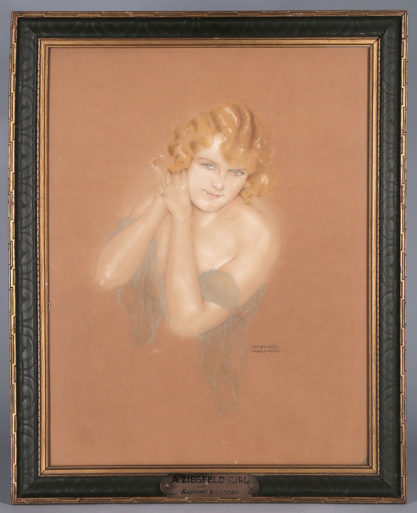This Raphael Kirchner Ziegfeld Follies pastel is a newly unearthed piece of New York City theater history, a once in a generation find. Part of a suite of five illustrations which feature the erotic and luminous showgirls who starred in the legendary theater revue Ziegfeld Follies and made the name synonymous with images of the most beautiful, brazen, and sensuous women in early 20th century New York. This portrait of Vivienne Segal hung in the lobby of the historic Century Theater until it shut its doors in 1936.
 |
| Above: The Century Girls Collection |
Florence Ziegfeld first achieved reputation as the Svengali-like manager of his tightly corseted wife Anna Held as an exotic toast of the continent, whom, he claimed loudly until the press took notice kept her porcelain skin pristine with daily milk baths. Ziegfeld found fortune extolling the sensational and scandalous habits of the beautiful showgirls he promoted and employed, creating an image of the follies girls which bordered on immoral and increased their allure. The Follies showgirls came to be known as “century girls” for their anti-Victorian spirit. The Ziegfeld Follies, with their veneration of female sexuality and promotion of new forms of pop culture, helped turn the early 20th century into an era of profound cultural change. This collection of paintings present a time capsule of that moment, and the five stars represented in these portraits are among the most enduring faces to come out of the decade.




Raphael Kirchner was born in Vienna, Austria and, along with Alphonse Mucha, was one of the most renowned art nouveau postcard artists in the Vienna Secessionist movement. The visionary artist later moved to France and worked as cover artist for the wildly popular La Vie Parisienne. His radically risqué portrayals of sexually emancipated women became known as “Kirchner Girls.” His images of libertine showgirls and nude concubines (who were often shown smoking, an activity at once taboo and suggestive) found fans among the avant-garde on both sides of the Atlantic. Kirchner moved to New York City in 1915, and was soon introduced to Florence Ziegfeld by Viennese architect Josef Urban, the man responsible for the ornate design and groundbreaking style which set the Follies apart from other provocative revues of the early 20th century. Ziegfeld, always an innovator, hired Kirchner as a staff artist.



Kirchner defined a new style for the Follies that was at once erotic, boldly independent, and whimsical. Kirchner painted theater mural portraits of the leading Follies girls, illustrated programs, and even designed costumes for Ziegfeld. In their short partnership the pair refined the look of the Ziegfeld Follies and gave the show a vanguard modernist sensibility. Few examples of Kirchner’s work for Ziegfeld have ever come on the market, and a find of this magnitude has never before been offered at auction. It is incomparable with any of Kirchner’s art that has previously been available and that we were able to reference. In historical significance, provenance, and quality it is unsurpassed.
 |
| Above: Raphael Kirchner cover predicting Alberto Vargas’ sensuality |

